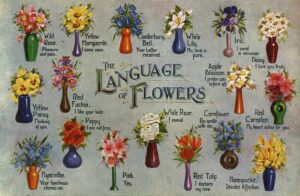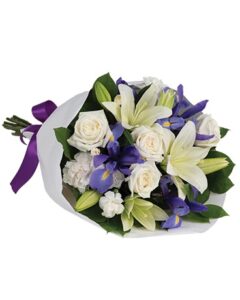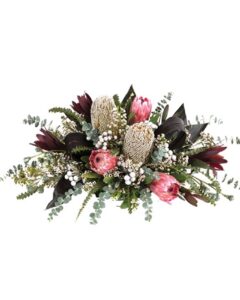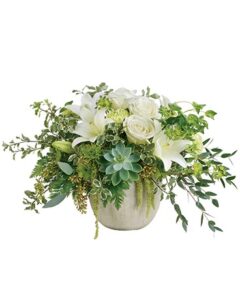The Meaning of Flowers
The Language of Blooms:
Exploring the Hidden Meanings and Symbolism Behind Flowers
 Flowers have always held a special place in our hearts, but did you know that they also have a secret language? In the world of botany, flowers communicate through symbolism and hidden meanings. From love and friendship to remembrance and hope, each bloom carries a unique message. In this article, we will delve into the fascinating language of blooms and explore the significance behind their colours, shapes, and fragrances.
Flowers have always held a special place in our hearts, but did you know that they also have a secret language? In the world of botany, flowers communicate through symbolism and hidden meanings. From love and friendship to remembrance and hope, each bloom carries a unique message. In this article, we will delve into the fascinating language of blooms and explore the significance behind their colours, shapes, and fragrances.
Whether you’re selecting a bouquet for a loved one or designing a garden, understanding the symbolic language of flowers can add an extra layer of meaning to your choices. Imagine the surprise and delight when you gift a bouquet that not only exudes beauty but also conveys a heartfelt sentiment.
Join us as we unravel the mysteries of the Language of Blooms. Discover the hidden meanings behind popular flowers like roses, lilies, and daisies, and how their symbolism varies across cultures and time. Learn how to create powerful floral arrangements to capture emotions and tell stories. Get ready to embark on a journey into a world where flowers speak louder than words.
Historical Significance of Flower Symbolism

The historical significance of flower symbolism is evident in many aspects of human culture, from literature and poetry to religion and art. Flowers have been used as symbols to express emotions, ideas, and virtues that are often difficult to convey in words.
The language of flowers, also known as floriography, originated in ancient times and developed through different civilizations and eras. For example, in Greek mythology, the rose was a symbol of love and beauty, associated with the goddess Aphrodite. In ancient Egypt, the lotus flower represented rebirth and creation, as it emerged from the muddy waters of the Nile. In Victorian England, flowers were used to communicate secret messages and sentiments, such as admiration, friendship, or sorrow.
The meaning of flowers can also vary by colour, shape, and number. For instance, a white rose signifies purity and innocence, while a red rose signifies passion and romance. A single flower can indicate simplicity and sincerity, while a bouquet can indicate abundance and gratitude. The historical significance of flower symbolism reflects the rich and diverse ways that humans have used nature to express themselves and connect with others.
Popular Flowers and their Meanings
Flowers are not only beautiful to look at, but they also convey various messages and emotions. Different flowers have different meanings and symbolism, depending on their colour, shape, and origin. Here are some of the most popular flowers and their meanings:
-
- Roses: Roses are the most classic and romantic flowers, often associated with love, passion, and admiration. The colour of the rose also affects its meaning. For example, red roses symbolize deep love and desire, while yellow roses symbolize friendship and joy.
- Lilies: Lilies are elegant and graceful flowers that represent purity, innocence, and beauty. They are often used in weddings and funerals, as they symbolize a new beginning or a farewell. Lilies come in various colours, such as white, pink, orange, and yellow, each with its own meaning. For example, white lilies symbolize sympathy and compassion, while pink lilies symbolize admiration and femininity.
- Sunflowers: Sunflowers are bright and cheerful flowers that symbolize happiness, loyalty, and optimism. They are named after the sun because they always face towards it, following its movement throughout the day. Sunflowers are also associated with longevity, faithfulness, and gratitude.
- Orchids: Orchids are exotic and sophisticated flowers that represent elegance, beauty, and luxury. They are also symbolling of fertility, sexuality, and mystery. Orchids come in a variety of shapes, sizes, and colours, each with its own unique charm and allure. For example, purple orchids symbolize royalty and admiration, while white orchids symbolize innocence and purity.
- Tulips: Tulips are simple and charming flowers that represent springtime, renewal, and hope. They are also associated with love, romance, and affection. Tulips come in many colours, such as red, yellow, pink, and purple, each with its own meaning. For example, red tulips symbolize true love and devotion, while yellow tulips symbolize cheerful thoughts and friendship.
How to use Flower Symbolism in Everyday Life
Flower symbolism is the art of using flowers to convey meanings, emotions, and messages. Flowers have been associated with various cultures, religions, and traditions for centuries, and they can express a range of sentiments from love and friendship to grief and apology. In everyday life, flower symbolism can be used to enhance communication, celebrate occasions, and decorate spaces. Here are some ways to use flower symbolism in everyday life:
-
- Send flowers as a gift. Flowers are a classic way to show someone you care, whether it’s for a birthday, an anniversary, or a thank you. You can choose flowers that match the personality, preferences, or zodiac sign of the recipient, or you can select flowers that have a specific meaning. For example, roses are a symbol of romance, carnations are a symbol of admiration, and orchids are a symbol of elegance. You can also mix different flowers to create a bouquet that expresses a complex message. For example, combining red roses and white lilies can signify passion and purity.
- Wear flowers as accessories. Flowers can also be worn as accessories to express your mood, style, or identity. You can wear flowers in your hair, on your clothes, or as jewellery. You can choose flowers that match your outfit, your season, or your occasion. For example, you can wear sunflowers in the summer to radiate joy and positivity, or you can wear daisies in the spring to symbolize innocence and freshness. You can also wear flowers that have a personal significance to you, such as your birth flower or your favourite flower.
- Decorate with flowers. Flowers can also be used to decorate your home, office, or event space. Flowers can add colour, fragrance, and beauty to any environment, and they can also create a certain atmosphere or vibe. You can choose flowers that match your theme, your purpose, or your mood. For example, you can use lavender to create a relaxing and soothing space, or you can use tulips to create a cheerful and lively space. You can also use flowers that have a cultural or historical meaning to you, such as your national flower or your heritage flower.
Flower Symbolism in Literature and Art
Flowers are not only beautiful and fragrant, but also rich in symbolism and meaning. They have been used as symbols in literature and art for centuries, often representing emotions, ideas, and virtues. This secret language of flowers, also known as floriography, allowed authors and artists to convey complex emotions and messages through their choice of blooms. For example, roses are the universal symbol of love, but they have different meanings depending on their color and number. Red roses signify passion and romance, while yellow roses express friendship and joy. Lilies are associated with purity and innocence, while orchids symbolize exotic beauty and elegance. Sunflowers represent happiness and loyalty, while daisies evoke innocence and simplicity. The symbolism of flowers can also vary across cultures and time periods, as different flowers may have different connotations and associations. Therefore, it is important to understand the context and the intention behind the use of flowers in literature and art, as they can reveal hidden meanings and insights about the characters, themes, and messages of the works.
Cultural Variations in Flower Symbolism

Flowers are often used as symbols of emotions, values, or messages in different cultures. However, the meanings of flowers are not universal and can vary significantly depending on the context, history, and beliefs of each culture. For example, in some cultures, white flowers are associated with purity, innocence, and peace, while in others, they represent death, mourning, and bad luck. Similarly, red flowers can signify love, passion, and courage in some cultures, but anger, violence, and danger in others. Therefore, it is important to be aware of the cultural variations in flower symbolism when choosing or sending flowers to someone from a different background or country. Otherwise, one might unintentionally convey a message that is offensive, inappropriate, or confusing to the recipient. In this paragraph, we will briefly explore some of the cultural variations in flower symbolism among some of the major regions of the world.
The Language of Blooms in Weddings and Special Occasions
Flowers are more than just beautiful decorations for weddings and special occasions. They also convey messages and meanings through their colours, shapes, and arrangements. The language of blooms, also known as floriography, is a centuries-old tradition that originated in ancient cultures and was popularized in the Victorian era. By choosing the right flowers, you can express your emotions, sentiments, and wishes to your loved ones and guests.
Some of the most common flowers used in weddings and special occasions are roses, lilies, orchids, carnations, and tulips. Each of these flowers has a different symbolism and significance depending on its colour and variety. For example, red roses represent love, passion, and romance, while white roses symbolize purity, innocence, and new beginnings. Lilies are associated with elegance, grace, and beauty, while orchids symbolize exoticism, luxury, and refinement. Carnations are versatile flowers that can convey different messages depending on their hue, such as pink for gratitude, white for remembrance, and red for admiration. Tulips are cheerful flowers that signify happiness, joy, and springtime.
When choosing flowers for your wedding or special occasion, you should consider the theme, season, location, and budget of your event. You should also consult with a professional florist who can help you create the perfect floral arrangements that suit your style and personality. By using the language of blooms, you can add more meaning and beauty to your celebration.
Growing and Caring for Symbolic Flowers
Growing and caring for symbolic flowers can be a rewarding hobby or a profitable business. Symbolic flowers are those that have a special meaning or significance, such as roses for love, lilies for purity, or sunflowers for happiness. Some people grow symbolic flowers to express their emotions, to celebrate occasions, or to honour someone they admire. Others grow symbolic flowers to sell them as gifts, bouquets, or decorations.
To grow and care for symbolic flowers, you need to consider several factors, such as:
-
- The type of flower and its symbolism. Different flowers have different meanings and associations, so you should choose the ones that match your purpose and preference. For example, if you want to grow flowers for a wedding, you might choose white roses for innocence, pink peonies for romance, or purple orchids for elegance.
- The climate and soil conditions. Different flowers have different requirements for sunlight, water, temperature, and nutrients. You should research the optimal conditions for your chosen flowers and provide them accordingly. For example, if you want to grow sunflowers, you need to plant them in a sunny spot with well-drained soil and water them regularly.
- The pests and diseases. Different flowers are susceptible to different kinds of insects, fungi, bacteria, or viruses that can harm them. You should monitor your plants for any signs of infestation or infection and treat them promptly. For example, if you notice aphids on your roses, you can spray them with insecticidal soap or neem oil.
- The pruning and harvesting. Different flowers need different methods of pruning and harvesting to maintain their health and appearance. You should learn how to prune your plants to remove dead or diseased parts, to shape them, or to encourage blooming. You should also learn how to harvest your flowers at the right time and in the right way to preserve their freshness and quality. For example, if you want to cut lilies for a vase, you should do it in the morning when the buds are still closed and use a sharp knife or scissors.
Growing and caring for symbolic flowers can be a fun and fulfilling activity that can brighten up your life and the lives of others. By following these tips, you can enjoy the beauty and meaning of your symbolic flowers for a long time.
Unusual and Lesser-Known Flower Meanings
Flowers are not only beautiful and fragrant, but they also have hidden meanings that can convey different messages. Some of these meanings are well-known, such as roses for love, lilies for purity, and sunflowers for happiness. However, there are also some unusual and lesser-known flower meanings that can surprise or intrigue the recipient. For example:
-
- Impatiens: These colourful flowers are often given to express impatience or eagerness. They can also symbolize a restless or lively personality.
- Asphodel: These delicate white flowers are associated with death and the underworld in Greek mythology. They can also represent regret or sorrow for something lost or forgotten.
- Tansy: These yellow flowers have a bitter taste and a strong smell. They are used to express hostility or resentment towards someone or something. They can also warn of danger or illness.
- Yellow Roses: These cheerful flowers are usually seen as a sign of friendship, joy, or appreciation. However, in some cultures, they can also imply infidelity, jealousy, or betrayal.
- Houseleek: These succulent plants are known for their ability to survive in harsh conditions. They symbolize vitality, resilience, and protection. They can also ward off evil or bad luck.
- Lobelia: These blue or purple flowers have a poisonous sap that can cause nausea or vomiting. They are used to convey malevolence, spite, or ill will towards someone. They can also indicate arrogance or pride.
- Rue: These herbaceous plants have a bitter taste and a medicinal use. They represent regret, repentance, or sorrow for a mistake or wrongdoing. They can also signify grace or forgiveness.
- Basil: These aromatic herbs are widely used in cooking and medicine. They express hatred, contempt, or disdain for someone or something. They can also indicate courage or strength.
These are just some examples of the unusual and lesser-known flower meanings that can add more depth and nuance to your floral arrangements. Next time you want to send a message with flowers, consider choosing some of these uncommon blooms to make your gesture more memorable and meaningful.
Conclusion to the Meaning of Flowers

Flowers have been used as symbols of emotions, messages, and cultural meanings for centuries. They can convey love, friendship, gratitude, sorrow, and many other sentiments. The meaning of flowers can vary depending on the type, colour, number, and arrangement of the blooms. Some flowers have universal meanings, such as roses for romance, lilies for purity, and sunflowers for happiness. Other flowers have different meanings in different cultures, such as chrysanthemums for mourning in Japan, lotus for enlightenment in India, and orchids for fertility in China.
The meaning of flowers can also change over time, as new associations and interpretations emerge. For example, tulips were once a symbol of wealth and power in the Ottoman Empire, but later became a symbol of love and passion in Europe. The meaning of flowers is not fixed or objective, but rather subjective and personal. Each flower can have a different meaning for each individual, depending on their own experiences, preferences, and emotions. Therefore, the meaning of flowers is not only a matter of historical and cultural context, but also a matter of personal expression and communication.
